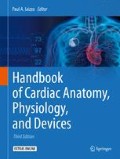Abstract
There are numerous congenital defects that may present with human hearts, and many typically require surgical intervention. The primary goal of this chapter is to briefly define such abnormalities and introduce the reader to the various classification schemes that have been used to describe their relative anatomical and functional features. The chapter will also highlight the more common surgical procedures utilized to treat congenital cardiac lesions.
Access this chapter
Tax calculation will be finalised at checkout
Purchases are for personal use only
References
Marelli AJ, Mackie AS, Ionescu-Ittu R, Rahme E, Pilote L (2007) Congenital heart disease in the general population: changing prevalence and age distribution. Circulation 115:163–172
Jacobs JP, Jacobs LJ, Mavroudis C et al (2008) Nomenclature and databases for the surgical treatment of congenital cardiac disease – an updated primer and an analysis of opportunities for improvement. Cardiol Young 18:38–62
Uemura H, Ho SY, Devine WA, Kilpatrick LL, Anderson RH (1995) Atrial appendages and venoatrial connections in hearts from patients with visceral heterotaxy. Ann Thorac Surg 60:561–569
Hagen PT, Scholz DG, Edwards WD (1984) Incidence and size of patent foramen ovale during the first 10 decades of life: an autopsy study of 965 normal hearts. Mayo Clin Proc 59:17–20
Campbell M (1970) Natural history of atrial septal defect. Br Heart J 32:820–826
Raghib G, Ruttenberg HD, Anderson RC, Amplatz K, Edwards JE (1965) Termination of left superior vena cava in left atrium, atrial septal defect, and absence of coronary sinus: a developmental complex. Circulation 31:906–918
Rao PS (1890) Fundamentals of clinical cardiology: a unified classification for tricuspid atresia. Am Heart J 99:799–804
Celermajer DS, Bull C, Till JA et al (1994) Ebstein’s anomaly: presentation and outcome from fetus to adult. J Am Coll Cardiol 23:170–176
Bailliard F, Spicer DE, Mohun TJ, Henry GW, Anderson RH (2014) The problems that exist when considering the anatomic variability between the channels that permit interventricular shunting. Cardiol Young 27:1–14 [Epub ahead of print]
Wilcox BR, Cook AC, Anderson RH (2005) Abnormal segmental connections. In: Wilcox BR, Cook AC, Anderson RH (eds) Surgical anatomy of the heart, 3rd edn. Cambridge University Press, United Kingdom, pp 157–170
Cho MS, Jang SJ, Sun BJ et al (2014) Prognostic implications of initial echocardiographic findings in adolescents and adults with supracristal ventricular septal defects. J Am Soc Echocardiogr 27:965–971
Smallhorn JF, Tommasini G, Anderson RH, Macartney FJ (1982) Assessment of atrioventricular septal defects by two dimensional echocardiography. Br Heart J 47:109–121
Villafane J, Lantin-Hermoso MR, Bhatt AB et al (2014) D-transposition of the great arteries; the current era of the arterial switch operation. J Am Coll Cardiol 64:498–511
Collett RW, Edwards JE (1949) Persistent Truncus arteriosus: a classification according to anatomic types. Surg Clin North Am 29:1245–1270
Van Praagh R, Van Praagh S (1965) The anatomy of common aorticopulmonary trunk (Truncus arteriosus communis) and its embryologic implications. A study of 57 necropsy cases. Am J Cardiol 16:406–425
Mori K, Ando M, Takao A, Ishikawa S, Imai Y (1978) Distal type of aortopulmonary window. Report of 4 cases. Br Heart J 40:681–689
Kutsche LM, Van Mierop LHS (1987) Anatomy and pathogenesis of aorticopulmonary septal defect. Am J Cardiol 59:443–447
Amato JJ, Douglas WI, James T, Desai U (2000) Coarctation of the aorta. Pediatr Card Surg 3:125–141
Celoria GC, Patton RB (1959) Congenital absence of the aortic arch. Am Heart J 58:407–413
Tchervenkov C, Roy N (2000) Congenital heart surgery nomenclature and database project: pulmonary atresia-ventricular septal defect. Ann Thorac Surg 69:S97–S105
Anderson RH, McCarthy K, Cook AC (2001) Double outlet right ventricle. Cardiol Young 11:329–344
Herlong JR, Jaggers JJ, Ungerleider RM (2000) Congenital heart surgery nomenclature and database project: pulmonary venous anomalies. Ann Thorac Surg 69:S56–S69
Wenink ACG, Gittenberger-de Groot AC, Brom AG (1986) Developmental considerations of mitral valve anomalies. Int J Cardiol 11:85–98
Barron DJ, Kilby MD, Davies B, Wright JGC, Jones TJ, Brawn WJ (2009) Hypoplastic left heart syndrome. Lancet 374:551–564
Lampros TD, Cobanoglu A (1998) Discrete subaortic stenosis: an acquired heart disease. Eur J Cardiothorac Surg 14:296–303
Fedak PWM, Verma S, David TE, Leask RL, Weisel RD, Butany J (2002) Clinical and pathophysiological implications of a bicuspid aortic valve. Circulation 106:900–904
Taylor AJ, Rogan KM, Virmani R (1992) Sudden cardiac death associated with isolated congenital coronary anomalies. J Am Coll Cardiol 20:640–647
Wesselhoeft H, Fawcett JS, Johnson AL (1968) Anomalous origin of the left coronary artery from the pulmonary trunk. Circulation 38:403–425
Author information
Authors and Affiliations
Corresponding author
Editor information
Editors and Affiliations
Rights and permissions
Copyright information
© 2015 Springer International Publishing Switzerland
About this chapter
Cite this chapter
Shepard, C., McIver, R., St. Louis, J.D. (2015). Congenital Cardiac Anatomy and Operative Correction. In: Iaizzo, P. (eds) Handbook of Cardiac Anatomy, Physiology, and Devices. Springer, Cham. https://doi.org/10.1007/978-3-319-19464-6_10
Download citation
DOI: https://doi.org/10.1007/978-3-319-19464-6_10
Publisher Name: Springer, Cham
Print ISBN: 978-3-319-19463-9
Online ISBN: 978-3-319-19464-6
eBook Packages: Biomedical and Life SciencesBiomedical and Life Sciences (R0)

